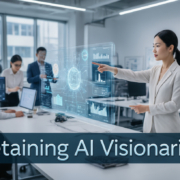Retaining AI Leadership: Long-Term Strategies to Keep Your AI Visionary Engaged
Let’s be honest: Losing your AI leader feels like watching your rocket ship lose its engine mid-launch. Sudden, terrifying, and potentially catastrophic.
About 76% of companies that lose their AI leadership see their innovative projects stall completely within six months. That’s not just a staffing issue—it’s an existential threat.
Retaining AI leadership talent requires more than competitive salaries. It demands understanding what truly drives these uniquely positioned professionals who straddle both technical mastery and strategic vision.
The playbook for keeping your AI visionary engaged isn’t found in standard HR manuals. It’s something more nuanced, more strategic, and frankly, more interesting than throwing money at the problem.
Want to know what works? The answer might surprise you—and it’s not what most executives think.
Understanding the AI Visionary Mindset

Key motivators that drive top AI talent
AI visionaries aren’t your typical tech leaders. They wake up thinking about neural networks and go to bed dreaming of algorithmic breakthroughs. What makes them tick?
First off, these folks crave intellectual stimulation like you crave your morning coffee. They need complex problems to solve—the kind that make regular engineers break out in a cold sweat.
Money? Sure, it matters. But wave a fat paycheck at an AI visionary while offering mundane work, and watch how fast they run the other way.
What gets them out of bed is impact. They want to see their code changing how businesses operate, how people interact with technology, or solving previously impossible problems.
Common frustrations leading to AI leader turnover
Your AI visionary is probably plotting their escape right now if:
- They’re drowning in meetings instead of building cool stuff
- The company treats AI as a buzzword rather than a strategic priority
- Their ideas keep hitting bureaucratic walls
Nothing kills an AI leader’s soul faster than being the “smartest person in the room” with no one to challenge them. Technical stagnation is career death to these people.
And here’s the kicker—most companies completely miss that their AI talent feels suffocated by short-term business pressures when they’re trying to solve decade-scale problems.
The innovation-satisfaction connection
The equation is surprisingly simple: Innovation opportunities = Happiness.
AI visionaries experience a genuine dopamine hit when they’re creating something new. Their brains are wired to seek novelty and breakthrough moments.
This creates a fundamental tension in many organizations. The business wants predictable, incremental improvements. Your AI leader wants to rethink everything from scratch.
Companies that understand this connection build sandboxes for experimentation. They create spaces where failure is acceptable as long as learning happens. Those that don’t watch their AI talent walk out the door.
Why traditional retention strategies fall short for AI leaders
Regular retention playbooks fail spectacularly with AI visionaries. Here’s why:
Annual reviews? Too slow and backward-looking for people working at the speed of AI advancement.
Standard promotion tracks? Often meaningless to someone who measures success by technical breakthroughs, not management titles.
The old “work-life balance” pitch? These folks often don’t see deep work as something separate from their identity.
Most damaging is the assumption that AI leaders are just like other tech executives. They’re not. They’re more like researchers and inventors trapped in corporate bodies, constantly weighing whether your company deserves their brainpower versus the startup they could launch tomorrow.
Innovative companies recognize this unique psychology and build custom environments that feed the visionary mind rather than constrain it.
Creating a Culture of Continuous Innovation

Establishing dedicated research time and resources
Your AI leaders aren’t just looking for a paycheck. They need mental oxygen to breathe new ideas into existence.
Give your AI visionaries dedicated time to explore. The 20% rule worked for Google, and it can work for you. One day a week where your AI talent can chase curiosities, dive into research papers, or test wild hypotheses.
But time alone isn’t enough. They need computing resources, access to datasets, and a budget for specialized tools. Nothing kills innovation faster than hearing “the cloud budget is maxed out this month.”
Building cross-functional innovation teams
AI doesn’t exist in a vacuum. Your visionaries thrive when partnered with product managers who understand market needs, designers who think about human experience, and domain experts who bring real-world context.
Create tiger teams that pull together different perspectives. The magic happens at the intersection of disciplines, not in isolated AI departments.
These teams should be small, autonomous, and laser-focused on specific challenges. Five brilliant minds with different backgrounds will outperform twenty experts from the same field every time.
Implementing sandbox environments for experimentation
Your AI leaders need playgrounds without guardrails.
Set up separate development environments to prevent experimental code from crashing production systems. Create data sandboxes with synthetic or properly anonymized data that let them test aggressive approaches without compliance headaches.
The best sandbox environments have:
- Flexible compute resources that scale up for intensive experiments
- Minimal approval processes for new tools and libraries
- Easy ways to document and share results
- Clear paths to production for successful experiments
Celebrating failed experiments as learning opportunities
The fastest way to drive your AI talent out the door? Punish failure.
Innovation requires risk, and risk means things will break. Create rituals around sharing what didn’t work.—monthly”glorious failure” meetings where teams present their dead ends and what they learned.
Document these failures in accessible knowledge bases. The experiment that failed today might be the foundation for tomorrow’s breakthrough when combined with a new approach.
And please, tie performance reviews to learning velocity, not just successful outcomes. Your AI leaders should feel safe taking big swings.
Connecting innovation initiatives to business impact
Even the most research-minded AI leaders want to see their work matter. Help them connect the dots between exploration and impact.
Create clear pathways from innovation to implementation. Pair researchers with product teams early. Bring customers into the innovation process to provide honest feedback.
Show your AI visionaries how their experiments translate to metrics:
- Revenue generated from new features
- Efficiency gains from improved algorithms
- Customer satisfaction improvements
- New markets opened by technical breakthroughs
When your AI leaders see their innovations changing your business, they’ll stick around to build what comes next.
Compensation Beyond Salary

A. Equity structures that align with long-term vision
Want to keep your AI visionary around for the long haul? Cash alone won’t cut it.
Innovative companies offer equity packages that mature over 4-7 years, not the standard 3-4. This sends a clear message: “We’re investing in your future with us.” For AI leaders who are building something revolutionary, this timeline makes sense.
Consider implementing:
- Refresher equity grants tied to major milestones
- Accelerated vesting upon breakthrough innovations
- Founder-like equity terms for true AI visionaries
One AI leader I spoke with turned down a higher-paying job because his current company offered a 7-year equity plan with exponential growth potential. “The longer I stay, the more ownership I feel,” he told me.
B. Performance incentives tied to innovation metrics
Ditch those cookie-cutter performance reviews. Your AI leaders aren’t motivated by the same things as everyone else.
Create innovation-specific metrics like:
- Patents filed and granted
- Research citations and influence
- Successful implementation of novel algorithms
- Technical debt reduction while maintaining innovation
Don’t just measure what’s easy to count. Measure what matters to your AI visionaries.
I’ve seen companies create “innovation bonus pools” where technical breakthroughs trigger significant financial rewards—sometimes 50-100% of base salary. These aren’t just annual bonuses; they’re immediate recognition when lightning strikes.
C. Research and publication opportunities
Your AI leaders didn’t spend years getting advanced degrees just to be locked in a corporate basement.
Top AI talent craves intellectual freedom. Give them:
- Protected time (20-30% minimum) for exploratory research
- Co-authorship on publications with your company’s backing
- Internal technical journals to showcase work that can’t be publicly shared
- Recognition as thought leaders, not just employees
Many companies fear letting their experts publish, thinking competitors will steal their ideas. The reality? Companies that encourage publication tend to attract and keep the best minds. The visibility becomes a recruitment tool.
D. Conference and continuing education budgets
The AI field moves at warp speed. Your leaders need to stay ahead.
Generous budgets should cover:
- Premium conferences ($5,000-15,000 annually per person)
- Advanced specialized training programs
- Sabbaticals for deep learning periods (3-6 months every 3-5 years)
- Budget for building their mini-teams to explore new directions
One AI director told me, “The annual NeurIPS conference is where I recharge my batteries. I come back with a notebook full of ideas and renewed excitement. That week is worth more than any bonus.”
Career Progression for Technical Visionaries

A. Dual-track advancement paths (management vs. technical)
AI visionaries often hit a ceiling where they must choose: lead people or keep building cool stuff. That’s a terrible choice to force on your top talent.
Innovative companies create parallel advancement tracks. Your technical stars can climb just as high as their management-oriented colleagues without sacrificing their hands-on work.
What this looks like in practice:
| Management Track | Technical Track |
|---|---|
| Team Lead | Principal Engineer |
| Director | Distinguished Engineer |
| VP | Fellow |
| CTO | Chief Scientist |
Each level should match in compensation, influence, and prestige. The titles matter less than the parity.
B. Creating specialized leadership roles
Ever notice how your AI visionaries light up when talking about specific domains? Create roles that capitalize on their unique obsessions.
Some specialized roles that work:
- AI Ethics Officer
- ML Infrastructure Architect
- Research Innovation Lead
- AI Strategy Advisor
These positions give technical leaders authority over critical domains without drowning them in generic management tasks they hate.
C. Strategic project ownership opportunities
Nothing kills a visionary’s spirit faster than being reduced to an “idea person” while others implement their vision.
Give your AI leaders complete ownership of high-impact initiatives that align with company goals. This means:
- Control over technical direction
- Input on team composition
- Direct line to executive leadership
- Visible attribution for outcomes
The projects should be ambitious enough to challenge them but defined enough to complete within 6-12 months. Quick wins matter.
D. External recognition and thought leadership development
Your AI stars probably dream about more than just internal success. They want industry recognition.
Help them build personal brands by:
- Sponsoring conference speaking opportunities
- Co-authoring research papers
- Creating company-branded content platforms
- Supporting open-source contributions
- Connecting them with media opportunities
This external validation isn’t vanity—it’s validation that their expertise matters beyond your walls. And when they’re recognized as industry leaders while representing your company? That’s the kind of loyalty money can’t buy.
Building the Right Team Around Your AI Leader

Hiring complementary technical talent
Your AI visionary needs a team that amplifies their strengths, not duplicates them. Think about surrounding your AI leader with people who can help fill their blind spots.
Most AI leaders are brilliant at conceptualizing breakthrough algorithms but might lack patience for production engineering. Or they’re phenomenal at research but struggle with translating that into business outcomes.
Find people who:
- Balance theory with practical implementation skills
- Bring diverse technical backgrounds (not just more ML experts)
- Challenge your AI leader intellectually without threatening them
- Handle the operational details your visionary might overlook
The magic happens when your AI leader feels understood technically but supported in areas where they’re not as strong. This creates an environment where they can focus on what they do best.
Strategic recruitment of implementation specialists
The gap between AI research and real-world deployment is massive. Your implementation specialists bridge that chasm.
These are the people who take your AI leader’s brilliant ideas and make them work in production. They’re the unsung heroes who:
- Translate complex models into scalable systems
- Build the infrastructure that supports AI deployment
- Handle the unglamorous but critical data pipeline work
- Navigate compliance and governance requirements
Without these specialists, your AI visionary’s ideas remain theoretical. With them, those ideas transform into business value.
Recruit people who have successfully shipped AI products before. They understand the practical constraints that pure researchers might miss.
Creating a balance between research and application
This balance is the secret sauce for keeping AI visionaries engaged long-term.
Too much focus on immediate application stifles innovation and bores your AI leader. Too much abstract research without real-world impact frustrates everyone else and drains resources.
The sweet spot? A portfolio approach:
- 60-70% focused on practical applications with clear ROI
- 20-30% exploring near-term innovations
- 10% pure blue-sky research
This creates a sustainable ecosystem where your AI leader can pursue intellectual challenges while still delivering measurable value. They get to see their ideas make a real impact while having space to explore what’s next.
Set up regular showcases where the research and application teams present to each other. These cross-pollination sessions often spark the most valuable innovations and keep your AI leader deeply engaged in both worlds.
Technology and Resource Investment

A. Commitment to cutting-edge infrastructure
AI visionaries don’t stick around in companies running on outdated tech stacks. Period.
Your top AI talent needs access to infrastructure that can handle the most demanding algorithms and the most extensive datasets. This isn’t just about having fast computers—it’s about creating an environment where technical limitations don’t bottleneck innovation.
Innovative companies invest in specialized AI hardware like custom TPUs, advanced GPUs, and purpose-built neural processing units. They also maintain flexible cloud computing arrangements that can scale instantly when that brilliant new idea needs testing.
What is the difference between adequate and cutting-edge infrastructure? About six months before your AI leader updates their LinkedIn profile.
B. Data access and quality improvement initiatives
Your AI leader is only as good as the data they can access.
Nothing frustrates a talented AI visionary more than brilliant ideas dying on the vine because of data problems. If they’re spending 80% of their time just cleaning data instead of building revolutionary models, you’ve got a retention problem brewing.
Set up dedicated data engineering teams to support your AI initiatives. Create streamlined processes for data access requests. Invest in automated data quality monitoring.
The companies keeping their AI talent happy are the ones treating high-quality data as a strategic asset, not an afterthought.
C. Computation resource allocation strategies
Let’s talk computing power politics.
In most organizations, computational resources are allocated based on seniority or business unit importance. That approach is the fastest way to lose your AI talent.
Innovative companies implement resource allocation strategies that prioritize innovation potential. They create dedicated compute clusters for AI research with minimal red tape. They set up fast-track approval processes for resource-intensive experiments.
Your AI leaders need to know they won’t be left waiting in line behind marketing’s email campaign when they’re ready to train a groundbreaking model.
D. Tools and platforms that enhance productivity
The toolset you provide speaks volumes about how much you value your AI talent’s time.
Top AI companies give their leaders access to:
- Premium subscriptions to research paper databases
- Advanced visualization tools
- Automated ML platforms for rapid prototyping
- Custom-built internal platforms that handle repetitive tasks
- Collaboration tools explicitly designed for AI workflows
Remember: every hour your AI visionary spends fighting with subpar tools is an hour they’re updating their resume.
E. Budget autonomy for experimental projects
Nothing says “I trust your judgment” like giving your AI leaders budget autonomy.
The most innovative AI work happens when visionaries can quickly test wild ideas without submitting forms in triplicate. Companies that retain their top talent give them:
- Discretionary research budgets
- Fast-track procurement processes
- Authority to acquire specialized datasets
- Ability to experiment without immediate ROI justification
When your AI leader spots a potential breakthrough, they shouldn’t need to wait for next quarter’s budget meeting to pursue it. By then, they might be pursuing it somewhere else.
Connecting AI Leadership to Strategic Business Outcomes

Involving AI leaders in business strategy sessions
Your AI visionaries aren’t just technical wizards—they’re strategic assets who need to be in the room where decisions happen.
Want to know why your AI leader is eyeing the exit? They’re probably tired of implementing someone else’s vision without input on the “why” behind it all.
Invite them to quarterly strategy sessions. Not as the “tech person” but as a core business strategist. Ask them directly: “How could AI fundamentally change our business model?” Then actually listen.
One CTO I know makes this a non-negotiable: “If I’m expected to build it, I need to be part of deciding what ‘it’ is.”
Translating technical achievements into business metrics
Your AI team just improved model accuracy by 6%. Great! But what does that mean for your bottom line?
AI leaders who stick around can answer that question in a heartbeat.
Create a simple translation framework:
- Technical win: 15% faster inference time
- Business impact: $2M saved in compute costs
- Customer win: Search results in 200ms instead of 500ms
The magic happens when your AI leader can walk into a board meeting and say: “Our technical improvements boosted customer retention by 8% this quarter.”
Creating visibility with executive leadership
Too many companies keep their AI talent hidden in digital basements—a big mistake.
Schedule monthly “AI impact” presentations where your AI leader presents directly to Cthe -suite—no middle managers filtering the message.
The format matters less than the frequency. Could be:
- 10-minute lightning updates
- Lunch-and-learns
- Executive “ride-alongs” through the AI pipeline
One AI director told me, “The CEO knowing my name and understanding my work is worth more than a 20% raise.”
Enabling direct customer or end-user interactions
Nothing—and I mean nothing—motivates an AI leader like seeing their work change someone’s life.
Break down the artificial wall between your AI team and the people using their creations.
Try these approaches:
- Quarterly customer site visits
- User testing sessions where AI leaders observe firsthand
- Customer advisory boards with AI leadership participation
- “Day in the life” shadowing opportunities
The emotional connection to real-world impact creates the stickiest retention strategy possible.
Long-term Retention Strategies

A. Personalized development plans with 3-5 year horizons
Keeping your AI visionaries engaged means thinking way beyond the typical annual review cycle. The best AI leaders are mapping their careers in multi-year arcs, not quarters.
A truly effective development plan for these individuals spans 3-5 years and gets specific about three critical areas:
- Technical mastery expansion (which emerging AI fields should they pioneer?)
- Leadership evolution (how will their influence scale as technologies mature?)
- Industry impact milestones (what breakthroughs will define their legacy?)
The trick? These plans can’t be cookie-cutter. Your AI visionary might be energized by the thought of publishing groundbreaking research papers, while another might crave building products that reach millions.
Check in quarterly on these plans, but resist the urge to micromanage. Top AI talent needs the psychological safety of knowing they have runway to experiment and occasionally fail.
B. Strategic sabbaticals and rejuvenation periods
Burnout is the silent killer of innovation. Your brightest AI minds are constantly processing complex problems, and their brains need deliberate recovery time.
Innovative companies are implementing sabbatical programs specifically designed for technical leaders. This isn’t just “time off” – it’s structured rejuvenation that might include:
- 6-8 week research immersions at partner universities
- Cross-industry explorations to find fresh AI applications
- Complete disconnection periods (yes, that means no Slack)
One AI director I know returned from a three-month sabbatical having completely reimagined their company’s approach to reinforcement learning. The ROI on their mental space was astronomical.
C. Creating internal venture opportunities
The entrepreneurial itch is real among top AI talent. They see possibilities everywhere and often dream of building something from scratch.
Instead of losing them to startups, create internal venture opportunities that provide:
- Dedicated resources and budget autonomy
- Small, handpicked teams with minimal bureaucracy
- Clear paths to spin out successful projects with equity considerations
Companies like Google have mastered this approach, allowing AI leaders to essentially found startups with the safety net and resources of a larger organization.
The psychological ownership that comes from leading these ventures creates a more profound commitment than any compensation package could.
D. Establishing mentor/advisory relationships with board members
Your AI visionaries need more than just technical challenges – they need to see how their expertise shapes strategic direction at the highest levels.
Creating direct relationships between your AI leaders and board members accomplishes two powerful things:
First, it gives your technical talent visibility into business strategy beyond their immediate scope.
Second, it helps board members develop a deeper appreciation for AI’s potential and limitations.
Structure these relationships carefully – quarterly dinners, monthly virtual coffee chats, or specific advisory projects work well. The format matters less than ensuring substantive exchange happens.
When your AI leaders feel their expertise influencing decisions at the board level, their commitment to your organization’s long-term success naturally deepens.

The journey to retain AI leadership requires a multifaceted approach that addresses both the unique mindset of AI visionaries and the organizational ecosystem in which they thrive. By cultivating a culture of continuous innovation, offering meaningful compensation packages, creating clear technical career paths, and surrounding these leaders with capable teams, organizations can significantly improve their retention success. Strategic technology investments and connecting AI initiatives to tangible business outcomes further demonstrate a commitment to both the leader and the discipline.
Ultimately, keeping your AI visionaries engaged is about recognizing their distinctive needs while integrating their expertise into the core of your business strategy. Implement these long-term retention strategies today to not only preserve your competitive edge in artificial intelligence but to empower your AI leaders to achieve their full potential within your organization. The companies that master this balance will lead the next wave of AI innovation and business transformation.
As organizations race to integrate artificial intelligence into their core strategy, identifying exemplary leadership has never been more critical. Learn how to position your team for success in The Race for Chief AI Officers: Why Every Board Wants One in 2025 and uncover effective search strategies. For guidance on securing an AI Visionary who can drive innovation and long-term value, Everest Recruiting delivers the expertise and network to lead the way.




